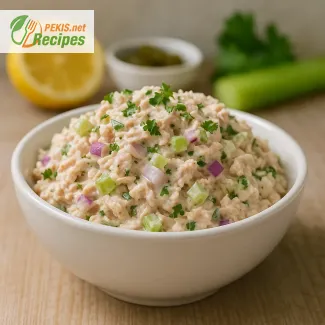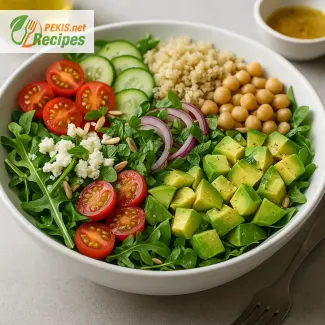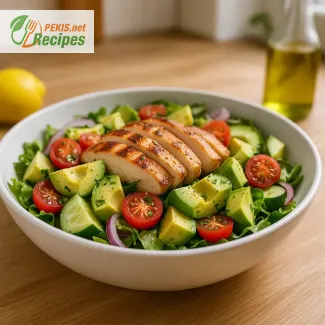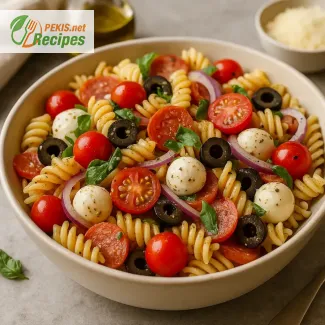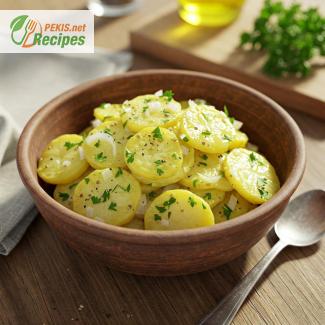
Discover the Rich Flavors of Traditional German Potato Salad
A warm and tangy twist on a beloved classic from Germany
Few dishes capture the comforting essence of European home cooking quite like a German potato salad. Unlike its creamy American cousin, this variation—known in its homeland as Kartoffelsalat—boasts a warm, vinegar-based dressing that brings out the natural sweetness of potatoes while adding a pleasantly tangy depth. With its roots embedded deep in Bavarian and Swabian culinary tradition, this salad is not just a side dish but a culinary statement, often served at festive gatherings, barbecues, and traditional German feasts.
This authentic Kartoffelsalat recipe focuses on the simplicity of ingredients while allowing each component to shine. It’s a salad that celebrates the humble potato in its most flavorful form. The warm dressing, typically made with mild vinegar, mustard, broth, and finely chopped onions, infuses the sliced potatoes with a deeply satisfying flavor. Some regional versions include crispy bacon or finely chopped pickles for added complexity, but at its core, this dish remains a study in balance—hearty, sharp, and slightly sweet.
The secret to a truly delicious German potato salad lies in the timing and technique. Potatoes must be cooked to perfection—tender but firm, never mushy. They should be sliced and dressed while still warm, allowing the flavors to fully penetrate each slice. This crucial step transforms the dish from something ordinary into something deeply satisfying and rich in traditional character.
Whether you are preparing it as a standalone meal, serving it alongside grilled sausages, or adding it to your Oktoberfest menu, Kartoffelsalat offers a rustic charm and a bold flavor profile that elevates any plate. It’s perfect for family dinners, potlucks, picnics, or whenever you want a side dish that brings something more than just texture—it brings a story, a heritage.
What sets this salad apart from others is its balance of acidity, mild sweetness, and savory notes. The use of vegetable or beef broth adds an unexpected heartiness that gives the dish depth, while a touch of mustard adds brightness and subtle spice. A dash of freshly ground pepper and a sprinkling of fresh parsley or chives add the finishing touches, making the salad not only flavorful but visually inviting.
This recipe for authentic German potato salad is more than just a set of instructions—it’s an invitation to experience the warmth and richness of traditional German cuisine. It’s also incredibly versatile: enjoy it warm as the Germans often do, or let it cool for a refreshing picnic option. Either way, it’s bound to be a crowd-pleaser.
With just a handful of pantry staples and a few key techniques, you can bring a taste of southern Germany to your table. From its soft, buttery potatoes to its punchy, savory dressing, this dish promises an unforgettable culinary experience. If you’ve never tried a warm potato salad before, prepare to fall in love with a dish that’s simple, yet unexpectedly full of flavor.
So roll up your sleeves, bring out your best potatoes, and let’s dive into the wonderful world of authentic Kartoffelsalat—a salad that’s stood the test of time and continues to delight taste buds around the world.
- Wash and cook the potatoes. Place the unpeeled waxy potatoes in a large pot and cover them with cold water. Add a pinch of salt and bring to a boil. Cook for about 20–25 minutes, or until tender when pierced with a fork.
- Drain and peel the potatoes. Once cooked, drain the potatoes and let them cool just enough to handle. Peel them while still warm and slice them into 0.5 cm (¼ inch) thick slices.
- Prepare the onion dressing. Finely chop the yellow onion and place it in a small saucepan. Add the vegetable broth and bring to a simmer. Cook for 2–3 minutes to soften the onions slightly. Then add the white wine vinegar, mustard, salt, and pepper. Stir to combine.
- Marinate the potatoes. Place the warm potato slices in a large bowl. Pour the warm onion-vinegar dressing over the potatoes and gently mix to coat all slices evenly. Let the potatoes absorb the dressing for at least 15 minutes.
- Add oil and herbs. Gently fold in the sunflower oil and chopped fresh parsley. Taste and adjust seasoning if needed.
- Serve. The salad can be served warm, at room temperature, or slightly chilled. Ideal as a side dish with sausages, schnitzel, or grilled vegetables.
Elevating the Classic: How to Enhance Your German Potato Salad
Creative tweaks and culinary techniques to perfect your Kartoffelsalat
When it comes to German potato salad, the original recipe already delivers a well-balanced harmony of savory, tangy, and slightly sweet flavors. However, even the most traditional dishes can be elevated through thoughtful adjustments, ingredient upgrades, and refined preparation techniques. Whether you're looking to intensify the flavor, improve the texture, or create a healthier version, there are many ways to give your Kartoffelsalat a modern twist while preserving its authentic charm.
Choosing the right potato variety makes all the difference
The cornerstone of any good potato salad is, of course, the potato itself. Traditionally, waxy potatoes such as Yukon Gold, Charlotte, or Nicola are used because of their ability to hold their shape after cooking. If you want to enhance the mouthfeel and absorbency of the dressing, consider using a combination of waxy and semi-waxy potatoes. This creates a contrast in texture—some pieces stay firm while others soften slightly and soak up more of the tangy broth.
Avoid using starchy varieties like Russets, which tend to break down and turn mushy, robbing the salad of its signature structure.
Infusing deeper flavor with homemade broth
Store-bought vegetable broth is a convenient option, but to truly elevate the dish, prepare your own broth. Simmer onions, carrots, celery, bay leaves, and peppercorns with a touch of apple cider vinegar to create a rich, aromatic base. This homemade infusion not only enhances the depth of flavor but also gives you full control over the sodium levels and seasoning profile.
For meat lovers, substituting part of the vegetable broth with beef or bacon broth adds a heartier, umami-rich undertone that aligns with traditional Swabian interpretations of the salad.
Transforming the dressing with specialty vinegars and oils
The classic dressing uses white wine vinegar and sunflower oil, but there is room for experimentation here. To deepen the flavor, try replacing white wine vinegar with apple cider vinegar, which brings a fruitier note, or sherry vinegar, known for its complex, slightly nutty finish. Adding a teaspoon of Dijon mustard can sharpen the dressing and create a silkier texture.
For a gourmet finish, consider using walnut or pumpkin seed oil instead of sunflower oil. These oils provide a luxurious mouthfeel and subtle earthiness, which pairs beautifully with the potatoes and onions.
Enhancing texture and balance with mix-ins
While the traditional recipe keeps things minimal, adding a few complementary ingredients can make a world of difference:
- Crispy bacon (optional for non-vegetarians): Adds saltiness and crunch.
- Cornichons or pickled cucumbers: Introduce a zesty sharpness and extra crunch.
- Capers: Offer a briny punch that contrasts nicely with the potatoes' softness.
- Radishes: Thinly sliced radishes add a peppery bite and vibrant color.
- Boiled eggs: Chopped hard-boiled eggs bring creaminess and a boost of protein.
Each of these ingredients contributes not only flavor, but also textural contrast and visual appeal, enhancing the overall dining experience.
Why homemade always wins
Preparing Kartoffelsalat from scratch allows for full control over each element. You're able to choose fresh, high-quality ingredients, adjust the seasoning to personal taste, and avoid preservatives or excessive salt found in many pre-packaged versions. The result is not only more delicious but also more wholesome.
Moreover, when you slice the potatoes while they’re still warm and immediately dress them, the warm dressing permeates the potatoes far more effectively. This process, which is harder to replicate in mass production, is what gives homemade Kartoffelsalat its uniquely rich and satisfying flavor.
Common pitfalls to avoid
Even simple dishes can go wrong. Here are a few mistakes to steer clear of:
- Overcooking the potatoes: This can lead to a mushy salad with little definition.
- Dressing cold potatoes: The dressing won’t absorb as well, resulting in blandness.
- Using the wrong vinegar: Strong, unbalanced vinegar types can overpower the dish.
- Neglecting seasoning: Under-seasoning is a common issue—taste and adjust regularly.
Healthier alternatives and dietary adjustments
For a lighter version, replace sunflower oil with extra virgin olive oil, which contains more monounsaturated fats beneficial for heart health. You can also cut down on sodium by using a low-salt homemade broth and skipping salty add-ins like bacon or pickles.
To make the salad more diabetic-friendly, incorporate high-fiber vegetables like celery or blanched green beans, which help slow carbohydrate absorption. For added plant-based protein, consider mixing in cooked lentils or chickpeas.
Adding layers with herbs and spices
While parsley is traditional, using a mix of herbs can elevate the herbal notes in the salad. Try adding:
- Chives: Provide a mild onion flavor with a touch of sweetness.
- Tarragon: Lends a slight anise flavor that enhances the mustard and vinegar.
- Dill: Offers a fresh, grassy finish that complements pickled elements.
A pinch of smoked paprika or caraway seeds can also introduce subtle aromatic undertones reminiscent of old-world European cooking.
Serving suggestions and presentation
To make your salad shine on the table, serve it in a ceramic or wooden bowl that retains heat, allowing the dish to stay warm longer. Garnish with a few extra parsley leaves or crispy shallots for a touch of texture and elegance. Pair it with grilled bratwurst, seared tofu, or a crisp green salad to turn it into a full meal.
Kartoffelsalat may seem humble, but with a few thoughtful changes, it can become a culinary centerpiece that celebrates both tradition and creativity.
- This recipe is gluten-free as written.
- Contains mustard, which is a common allergen.
- Onions may trigger intolerance in sensitive individuals.
Suggestions for allergen replacement:
- Mustard-free version: Replace mustard with a dash of lemon juice and a pinch of turmeric for color and tanginess.
- For onion sensitivity, use chives or the green part of spring onions sparingly.
- Vitamin C: 18 mg – supports immune function and skin health
- Vitamin B6: 0.4 mg – important for metabolism and nervous system
- Potassium: 650 mg – supports heart health and fluid balance
- Iron: 1.2 mg – helps transport oxygen in the blood
- Magnesium: 30 mg – aids in muscle and nerve function
- Flavonoids from onions: ~12 mg – contribute to reduced inflammation and heart protection
- Vitamin C: ~18 mg – acts as an antioxidant and supports collagen synthesis
- Polyphenols from vinegar: ~5 mg – may aid in digestion and glycemic control


